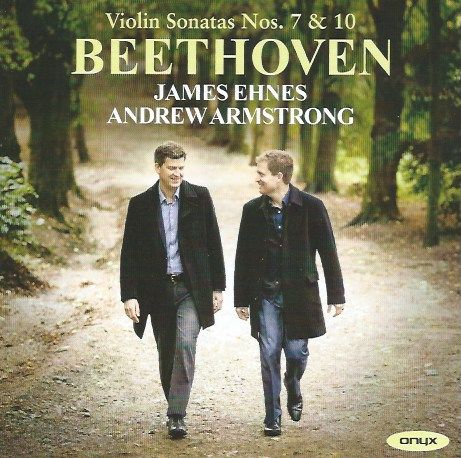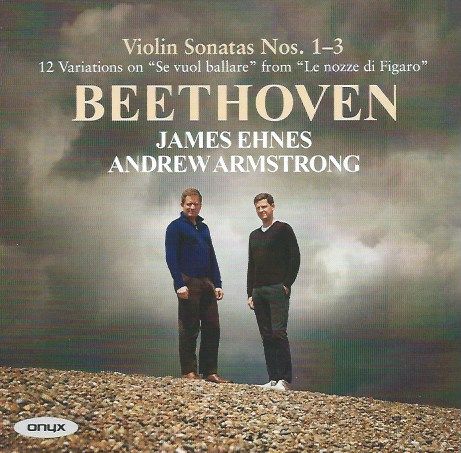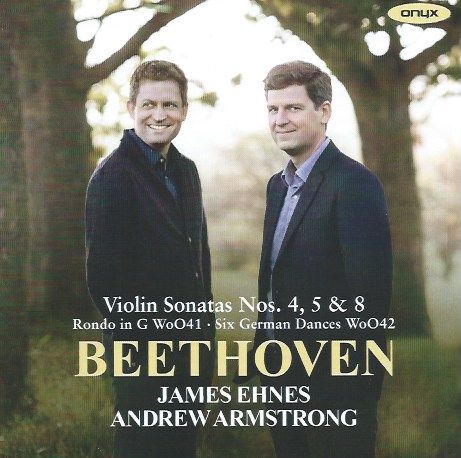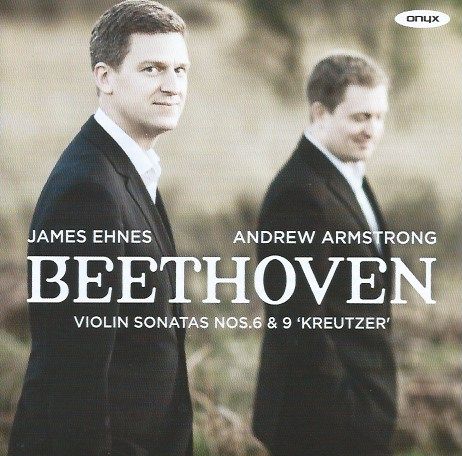Beethoven Violin Sonatas from Onyx

This is an ongoing series of consistent excellence: modern performances is state-of-the-art sound. In a year that could have held so much more Beethoven, not least live, it is good to see the ten violin sonatas, now complete, from two fresh, invigroated performers in performances of depth and vision. The recordings offer a welcome opportunity to have a look at the sonatas afresh, too.
Beethoven composed ten violin sonatas between 1798 and 1812. Although they don't span his creative life in the way the string quartets or piano sonatas do, they comprise one of the most important sets for this combination in the repertoire.
The most recent release only came out on December 11, 2020, and the final sonatas in the series were No. 7 in C minor, Op. 30/2, and No. 10 in G major, Op. 96:

The Seventh Sonata is the C minor, Op. 30/2 (1802). Perhaps the subject of a future post could be on nicknames and why pieces without them suffer. Haydn's symphonies are a case in point: people make a beeline for a "Drumroll" or a "London" but there is any number of unnamed symphonies that offer delight and are unalloyed masterpieces. The same could be said for some of the Beethoven Violin Sonatas. Op. 30/2 is a wonderful masterwork, Beethoven matching flow of invention with compact thematic workings, taking motifs and subjecting them to a plethora of manipulations:
After the rigour of the first movement, the A flat major slow movement offers a place of rest (much as the parallel famous A flat major slow movement of the "Pathétique" Piano Sonata, Op. 13, offers rest after that piece's tumultuous C minor first movement). It also offers an insight into the rapport between Ehnes and Armstrong:
The four movements of Op. 30/2 make the perfect whole. That rapport between Ehnes and Armostrong manifests in a different way in the light, playful (but always clearly Beethoven) Scherzo and the rugged machinations of the finale. A great performance.
The C Minor Sonata, Op. 30/2 is coupled with the G major, Op. 96 (No. 10). The G major piece makes for a perfect contrast, in a relaxed key and exuding a sense of effortless flow (and the perfect demonstration of the warmth between these two performers and how that can manifest in sound). In terms of composition date, it stands in splendid isolation amongst the violin sonatas (1812), currounded in Beethoven's output by works such as the famous "Archduke" Piano Trio or the F minor String Quartet, Op. 95. The slow movement has more than a touch of the late period about it, certainly here in Ehnes and Armstrong's performance.
Going back now to the beginning of the series, the first volume gives us the three sonatas of Op. 12, plus a set of variations (more on this last later).

The Op. 12 Violin Sonatas date from 1797/8 and were dedicated to Salieri. Early period works, then: all very much in Beethoven's own voice. The first is in D major, rambunctious and boisterous, and how well Ehnes and Armstrong conspire to create this impression while allowing us to marvel at Beethoven's genius:
Listen to the equality between violin and piano, both in Beethoven's writing (alhtough published as for "fortepiano and violin," the equality of the instruments is beyond doubt) and between Ehnes and Armstrong. And the second movement furnishes an example of one of Beethoven's most favoured mediums, that of theme and variations:
What Beethoven does in the Second Sonata (A major) is to present a tight first movement with plenty of "themes" and "motifs" ; so that when melody lies at the heart of a movement, as it does in Andane più tosto allegro second movement, it radiates its pathos all the more:
But when it comes to truly sublime music, its Op. 12/3 that really flies. The first movement fits the bill nicely:

The second volume includes Opp. 23 and 24. While the second is the most famous, the so-called "Spring" Sonata (those nicknames again!), Beethoven intended the two as a contrasting pair. The A-Minor, op. 23 is brooding, dramatic, the close of the first movement an unexpected masterstroke. But we'll hear the sheer energy of the finale:
The "Spring" Sonata is one of the most famous of the Violin Sonatas, and no wonder what with that glorious violin melody of the opening:
This is a truly fabulous performance, the unruffled first movement ceding to the most gloriously serene Adagio molto espressivo, heard here in one of the finest performances available:
The un-nicknamed (is that even a word?!) Violin Sonata Op. 30/3 in G is another gem that sometimes goes under the radar. As you get further and further into the first movement, the music seems to buzz with energy (those tight trills help):
I'll leave you to find satisfaction in Ehnes' throaty sound in the violin's low register in the second movement (a rather long indication here: Tempo di Menuetto, ma molto moderato e grazioso). An undercurrent of a drone enlivens the dance-like finale:
The pairing of the "Kreutzer" Sonata, Op. 47, and the A major Sonata, Op. 31/1 is made in Heaven and forms the basis for the next volume:

It is no surprise there are only two sonatas here, for one is the broadest of all, the "Kreutzer" (the work, although originally dedicated to a violinist by the name of George Bridgetower, was subsequently dedicated to Rodolphe Kreutzer). It's a piece that appears in the writings of one Leo Tolstoy, a short story called The Kreutzer Sonata, a connection explored by violinist Jack Liebeck and pianist Yulia Chaplina at London's King's Place in October this year (see my review here). The slow unfolding of the quarter-hour central Andante con variazioni (yes, another variation set) is brilliantly judged by Ehnes and Armstrong:
The Sixth Sonata is one of the lesser-known ones. Cast in A major (Op. 30/1), it seems a perfect, and relaxed, way to close this overview of the sonatas, and of the new Onyx cycle. The finale, another set of variations, seems the perfect way to round off the main body of the article:
As in Martino Tirimo's Beethoven set, it is the lesser-known works that can be so memorable: the variation sets and so on. The set of variations on "Se vuol ballare" from Mozart's Figaro, WoO 40 (1793) at the end of the Op. 12 disc reminds us of the lighter side of Beethoven, notwithstanding the minore seventh variation. And who doesn't like a set of German Dances (Deutsche Tänze, 1795/6)? The set of six arrives in between the "Spring" and Op. 30/3 Sonatas, full of gritty vim, along with the Rondo in G, WoO 41 (1790-92) a piece I have to admit was new to me. Gleamingly fresh both in demeanour and execution, what a lovely encore piece this Rondo would make. (it lasts the perfect encore length, too, some four minutes). It seems the ideal way to close:
Although not issued as a set per se, this collection of four discs offers some of the most rewarding, insightful Beethoven of 2020.
